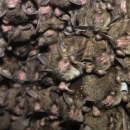The Indiana bat (Myotis sodalis) was originally listed as being in danger of extinction under the Endangered Species Preservation Act of 1966 (32 FR 4001, March 11, 1967), and is currently listed as endangered under the Endangered Species Act (ESA) of 1973, as amended. Therefore, the U.S. Fish and Wildlife Service (Service) has a statutory requirement to conserve the Indiana bat. To help target conservation actions and to determine whether actions may impact Indiana bats, it is necessary to understand the species’ distribution on regional and local landscapes. Although we have successfully monitored this species in the winter when large concentrations of Indiana bats are clustered in caves and mines, locating Indiana bats in the summer when maternity colonies are scattered across the eastern half of the United States has continued to be a monitoring issue. This challenge has increased and will continue to grow as white-nose Syndrome (WNS) continues to adversely impact Indiana bat populations. As a consequence, the Service is in the process of revising its recommended summer survey guidance. As part of this revision, we must ensure that the methods and levels of survey effort are adequate to detect the species and provide confidence in negative results.
Publication date
Media Usage Rights/License
Public Domain
Program
Species
FWS Focus


